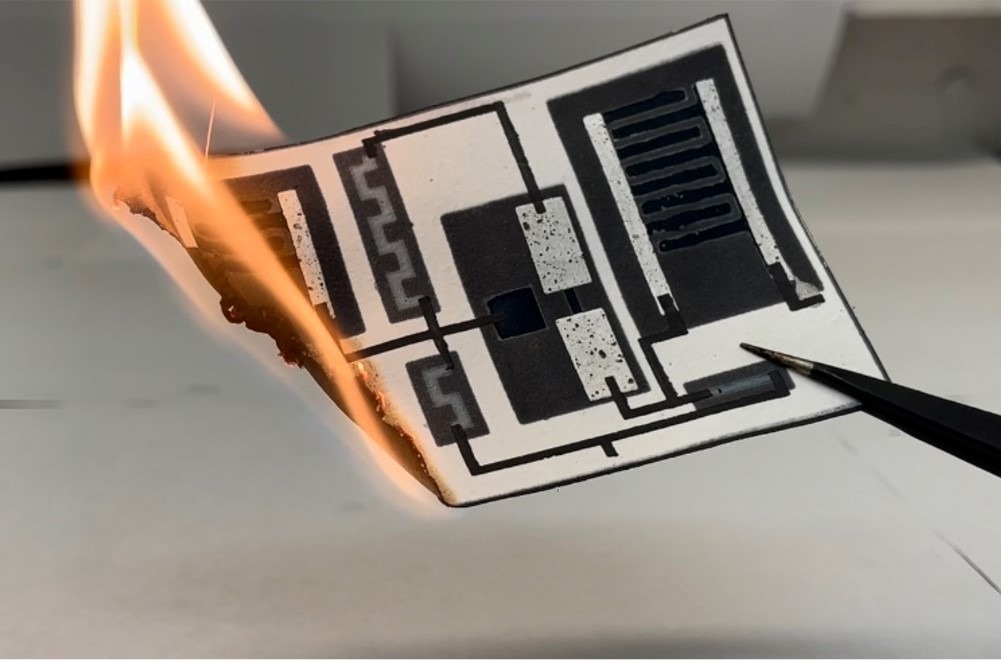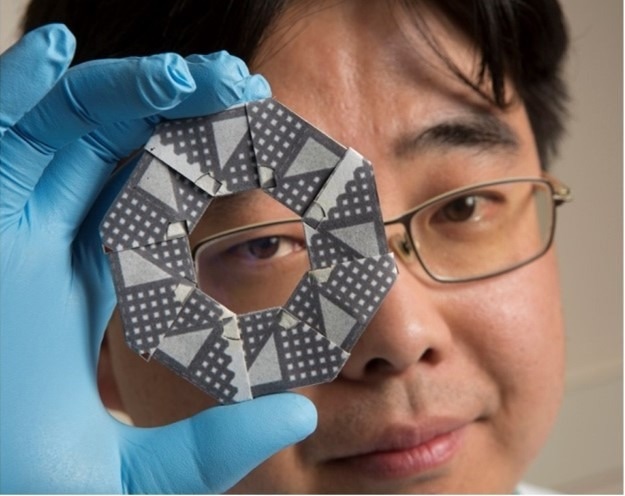AZoM speaks with Seokheun Choi, a Professor in the Department of Electrical & Computer Engineering at the State University of New York. His new research details the production of a prototype circuit board printed on a sheet of paper.
Please can you introduce yourself, your professional background, and how you came to be involved with electronic innovation?
My long-term goal is to create green and renewable electronic systems and advance their translational potential toward practical, real-world disposable Internet of Things (IoT) applications. The current papertronic work is the next logical step for ideas and observations made in my earlier work with paper-based biobatteries, and it is part of a recent mission to create a self-powered paper-based biosensing system. My work in papertronics, paperfluidics, flexible electronics, and green electronics has segued toward designing integrated papertronics for real-world applications. I am one of the handful of pioneers in paper-based biobatteries and papertronic research, and has recently published major reviews of the full scope of paper-based batteries and their applications.
How significant is the problem of electronic waste? Why is it so difficult to recycle?
As electronics become increasingly pervasive and fast updates lead to quick obsolescence, electronic wastes mount tremendously, developing severe, negative effects on the environment and public health. The United States generated about 7 million tons of electronic waste in 2019, of which only about 17% was recycled. It is very difficult to recycle electronic devices because they are not technically designed to be recycled and possess non-biodegradable and toxic inorganic materials.
You have created a prototype circuit board on a sheet of paper. How is this possible?
Paper exhibits superior compatibility with single-use applications, offering a more affordable, readily available, flexible, and easily disposable alternative. The biodegradability of paper has attracted much attention as the future of green electronics, reducing the dramatic increase in electronic waste. Moreover, because of its excellent mechanical and dielectric properties with chemical and thermal stability, paper has emerged as a game-changing substrate for next-generation electronics, known as papertronics.

Image Credit: Seokheun Choi
The natural compatibility of paper with wicking, printing, and stacking allowed us to minimize the fabrication processes and device design complexity by exploiting all beneficial properties of paper in a cost-effective and eco-friendly way. Via wax-printing, paper ink injection, and screen printing, the metallic wires were able to maintain flexibility while attaining complete integration with the paper substrate.
What potential future applications could these paper-based electronics support?
The papertronics will be suitable for disposable wireless sensor networks (WSNs) through the internet of things, named the internet of disposable things (IoDT). The novelty in the IoDT is that its WSNs can be constructed with small, compact, disposable, functional, but inexpensive packages that can connect until the job is done and then be readily thrown away. The IoDT devices will provide a great degree of intelligence and autonomy by enabling rapid deployment of new applications and the creation of services at an affordable price point, such as point-of-care personalized healthcare systems, logistics and shipment tracking solutions, food and grocery monitoring systems, and military surveillance or delivery systems.
What is the innovation of this research and what is the most significant or exciting part to you?
Even the latest attempts to use paper for electronics did not go further than conceptual research and failed to ensure its translational potential toward practical, real-world applications. Paper could serve only as a substrate for mounting non-paper, off-the-shelf, standard-material electronic components, which precluded an entirely paper-based device platform, making it difficult to completely recycle and eliminate environmental footprints.

We provided a fully paper-based device with all paper components on paper printed circuit board. In particular, a methodology was discussed for simultaneously achieving very tunable resistors, supercapacitors, and electrolyte-gated field-effect transistors on and within the thickness of a single sheet of paper. Each electronic component was completely integrated into functionalized paper regions and exhibited favorable electrical activity, adjustability, flexibility, and disposability.
How well do these papertonics perform compared to traditional electronics?
The goal of this project was not to replace the conventional inorganic-based electronic industry. Rather, it offered opportunities for new techniques, applications, and markets in a way to reduce the dramatic increase in electronic waste. Disposable, single-use operation for a short-programmed period will not require high-tech integrated circuits with high resolution and reliability. However, more research work for higher density and performance will be performed.
What other materials are used in these paper-based electronics?
Given that biodegradable electronics made from completely biodegradable materials will address the uncontrollable e-waste issue, intensive technological advances in materials science and processing with paper will be indispensable. Although the project tried to use biocompatible synthetic polymers, and eco-friendly semiconducting, conducting, and insulating materials, the discovery and engineering of biodegradable materials were outside the scope of this project. The focus of this work was to understand the potential of paper as a substrate and establish an innovative strategy to integrate existing electronic components into paper and develop the manufacturing paradigm. However, ingredients will be replaced with more biodegradable materials in future work.
How can these circuit boards be disposed of? Are there any harmful byproducts?
Our all-paper device for single-use applications can be easily and safely disposed of through incineration or biodegradation. We showed our paper-printed circuit boards being reduced to ashes 20 s after ignition. Some byproducts are generated, which may be harmful to the environment. However, if the devices can be disposed of by incineration only, we can dramatically decrease electronic waste. Incineration facilities can incorporate many techniques to ensure proper combustion and reduce emissions.
What limitations must be overcome before this technology can be scaled up?
Additional packaging will be required for all paper-based devices because humidity may dramatically change paper morphology and degrade its performance and shelf life. Furthermore, some potential exposure of paper to other microorganisms can biodegrade the paper through their enzymatic activities.
Where can readers find more information?
1. M. Landers, A. Elhadad, M. Rezaie, and S. Choi, “Integrated Papertronic Techniques: Highly Customizable Resistor, Supercapacitor, and Transistor Circuitry on a Single Sheet of Paper,” ACS Applied Materials & Interfaces, 14, 45658-45668, 2022 https://pubs.acs.org/doi/10.1021/acsami.2c13503
2. S. Choi, “Electrogenic Bacteria Promise New Opportunities for Powering, Sensing, and Synthesizing,” Small, Review Article, 18 (18), 2107902, 2022 https://onlinelibrary.wiley.com/doi/abs/10.1002/smll.202107902
3. Y. Gao and S. Choi, “Stepping Towards Self-powered Papertronics: Integrating Biobatteries into a Single Sheet of Paper,” Advanced Materials Technologies, 2, 1600194, 2017 https://onlinelibrary.wiley.com/doi/abs/10.1002/admt.201600194
About Seokheun Choi
 Seokheun “Sean” Choi is a Professor in the Department of Electrical & Computer Engineering at State University of New York (SUNY)-Binghamton. Currently, he is running “Bioelectronics & Microsystems Lab” and “Center for Research in Advanced Sensing Technologies & Environmental Sustainability” as a Director. His current research focuses on the next generation “Electronics, Sensors and Power technologies,” including self-powered electronics, wearable and stretchable sensors, biobatteries, papertronics, and fibertronics. Over the years, he has secured funding over $4 million from NSF, ONR, and SUNY Research Foundation. He has authored over 150 journal and conference articles, two book chapters, and one book, and hold two U.S. patents. For more information, feel free to visit his research website, http://ws.binghamton.edu/choi/.
Seokheun “Sean” Choi is a Professor in the Department of Electrical & Computer Engineering at State University of New York (SUNY)-Binghamton. Currently, he is running “Bioelectronics & Microsystems Lab” and “Center for Research in Advanced Sensing Technologies & Environmental Sustainability” as a Director. His current research focuses on the next generation “Electronics, Sensors and Power technologies,” including self-powered electronics, wearable and stretchable sensors, biobatteries, papertronics, and fibertronics. Over the years, he has secured funding over $4 million from NSF, ONR, and SUNY Research Foundation. He has authored over 150 journal and conference articles, two book chapters, and one book, and hold two U.S. patents. For more information, feel free to visit his research website, http://ws.binghamton.edu/choi/.
Disclaimer: The views expressed here are those of the interviewee and do not necessarily represent the views of AZoM.com Limited (T/A) AZoNetwork, the owner and operator of this website. This disclaimer forms part of the Terms and Conditions of use of this website.